Watching birds visit a backyard birdhouse is just the best! The right color choice can make a significant difference in attracting specific bird species to these cozy homes. Birds are naturally drawn to particular colors, with purple, blue, and earth tones being among the most effective for attracting common backyard species like bluebirds, wrens, and chickadees.
Many feathered friends use color to identify safe nesting spots and reliable food sources. A thoughtfully painted birdhouse can be an inviting beacon, encouraging birds to make themselves home in the garden.
The perfect birdhouse color combines both practical and aesthetic considerations. While some birds prefer natural wood tones that blend with their environment, others are attracted to bright, eye-catching shades that remind them of their favorite foods or flowers.
Understanding Bird Color Preferences

Birds show distinct preferences for specific colors, with their choices often tied to their natural behaviors and survival instincts in the wild.
Scientific Basis for Color Attraction
Birds possess exceptional color vision, seeing a broader spectrum than humans. Many species can even perceive ultraviolet light, which influences their selection of feeding and nesting spots.
Research demonstrates that certain bird families gravitate toward specific hues. Warblers and finches often select yellow and red objects, while bluebirds naturally seek out blue tones.
The strength of color preference varies by season. During breeding periods, male birds become more attracted to vivid colors that match their own plumage.
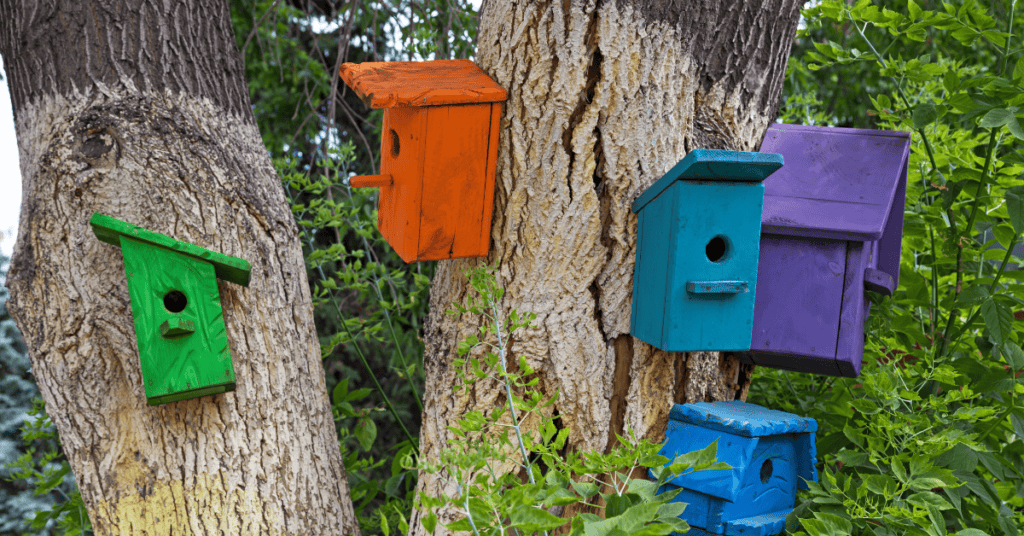
How Colors Affect Bird Behavior
Different colors trigger distinct behavioral responses in birds. Red frequently stimulates feeding behavior, which explains why hummingbirds readily visit red feeders and flowers.
Bright blues and greens can signal safe nesting areas to cavity-dwelling birds like chickadees and nuthatches. These colors remind them of natural holes in living trees.
Studies show that cardinals and robins visit red and orange birdhouses more frequently than neutral-colored ones.
Earth tones like brown and gray help birds feel secure, as these colors blend with natural surroundings and provide camouflage from predators.
Choosing the Right Birdhouse Color
The perfect birdhouse color helps attract desired bird species while keeping them safe from predators. Paint choice can significantly impact how many feathered friends visit your garden.
Natural Colors and Camouflage
Browns, greens, and grays blend seamlessly with natural surroundings, like trees, plants, and grass. In turn this makes these colors excellent choices for birdhouses. These earth tones help protect birds from predators while maintaining the garden’s natural aesthetic.
A light tan or soft brown birdhouse works well in open areas near trees, mimicking natural wood colors that birds instinctively trust. Forest green shades provide excellent camouflage when placed near bushes or foliage.
Gray tones match tree bark perfectly, creating a secure feeling for cavity-nesting birds like chickadees and wrens. These natural colors also weather gracefully, requiring less maintenance over time.
Bright Colors and Visibility
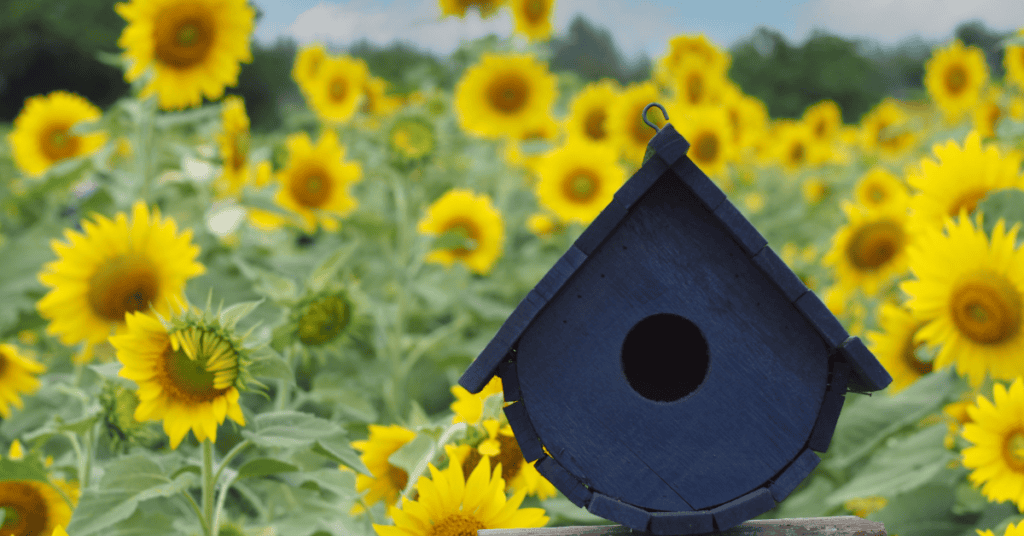
Purple martins and bluebirds often show a preference for brighter-colored houses. White, light blue and pale yellow attract these species while reflecting heat in sunny locations.
Hummingbirds respond positively to red and pink colors, similar to their favorite flowers. But they don’t nest in birdhouses.
Consider using a mix of soft pastels like light green or baby blue – these colors provide enough visibility without overwhelming the garden space.
Colors to Avoid in Birdhouses
Black and dark-colored birdhouses absorb too much heat, potentially creating dangerous conditions for nestlings during summer months. These colors should be avoided, especially in sunny locations.
Metallic or reflective paints can disorient birds and attract unwanted attention from predators. They also create glare that may deter birds from approaching.
Neon colors often appear unnatural to birds and might reduce nesting activity. Stick to softer tones that better match their natural habitat preferences.
Bird-Specific Color Preferences
Different bird species strongly attract specific colors when selecting nesting sites, influenced by their natural habitats and instinctive behaviors. These color preferences are crucial in attracting desired birds to backyard birdhouses.
Eastern Bluebirds and Earth Tones
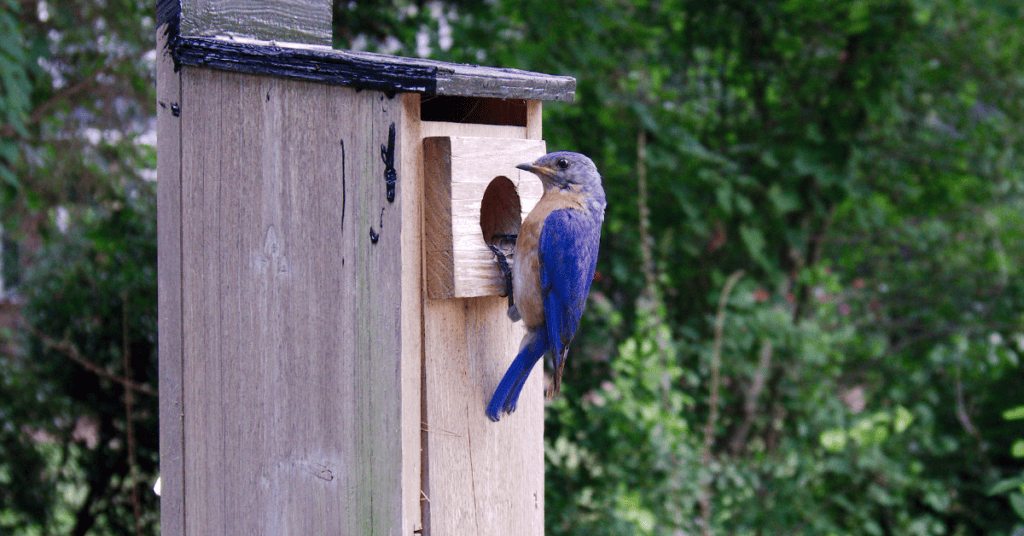
Eastern Bluebirds naturally gravitate toward earth-toned birdhouses that blend with their woodland environment. Natural cedar and light brown shades prove particularly appealing to these beautiful songbirds.
Studies show that Eastern Bluebirds readily accept houses painted in soft browns, tans, and gray-green colors. These colors mimic the natural tree cavities they seek in the wild.
When selecting paint for bluebird houses, matte or semi-gloss finishes work best. Glossy finishes can create unwanted reflections that may deter these sensitive birds.
Hummingbirds and Bright Shades
Hummingbirds strongly attract vibrant colors, particularly red and pink shades. These tiny birds associate bright colors with nectar-rich flowers in their natural habitat.
Paint choices in coral rose and bright pink can make hummingbirds visit a feeder, but they dont set upshopin nest boxes.
American Robin and Neutral Colors
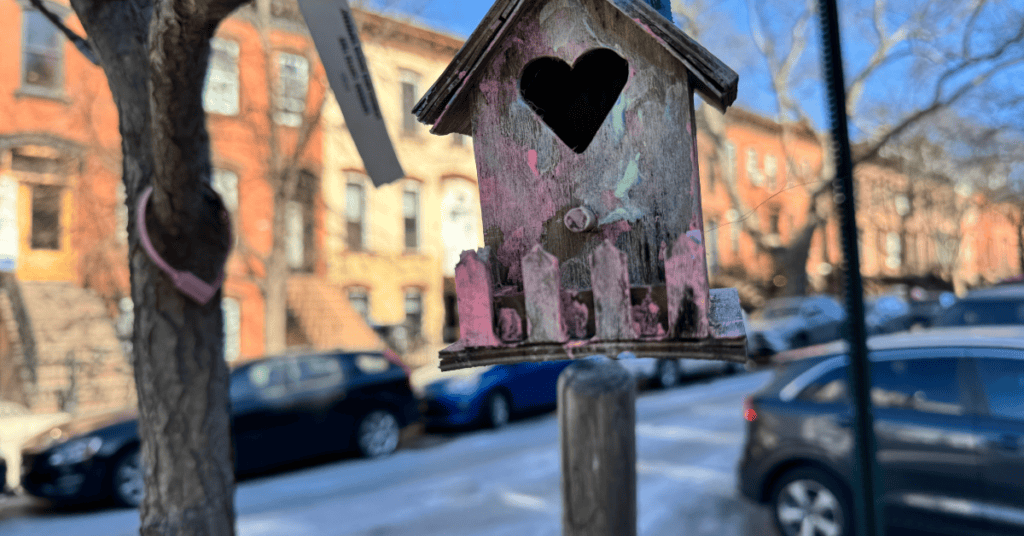
American Robins prefer nesting boxes in neutral shades that match their natural nesting locations. Gray, brown, and dull green colors attract these common backyard birds.
These colors help robins feel secure by providing camouflage from predators. Houses painted in dark earth tones receive the most robin activity.
Weather-worn wood and natural cedar appeal strongly to robins. These materials resemble their preferred nesting spots in tree forks and building ledges.
Owls
Owls favor dark-colored houses that provide maximum concealment. Deep browns and grays help create the secure, cave-like environment they seek.
Recommended Owl House Colors:
- Dark brown
- Charcoal gray
- Forest green
- Natural weathered wood
Rough or textured surfaces on owl houses provide better camouflage than smooth finishes. More importantly, paint them with flat or matte finishes to reduce any shine that might reveal the nest location.
The Role of the Environment
Environmental factors, like rain, freezes, and snow will play a vital role in determining the success of your birdhouse. Like if it rains alot you’ll need a strategic place for your birdhouse. and its ability to attract desired bird species. Natural surroundings influence both bird behavior and their color preferences.
Matching Birdhouse Colors to Surroundings
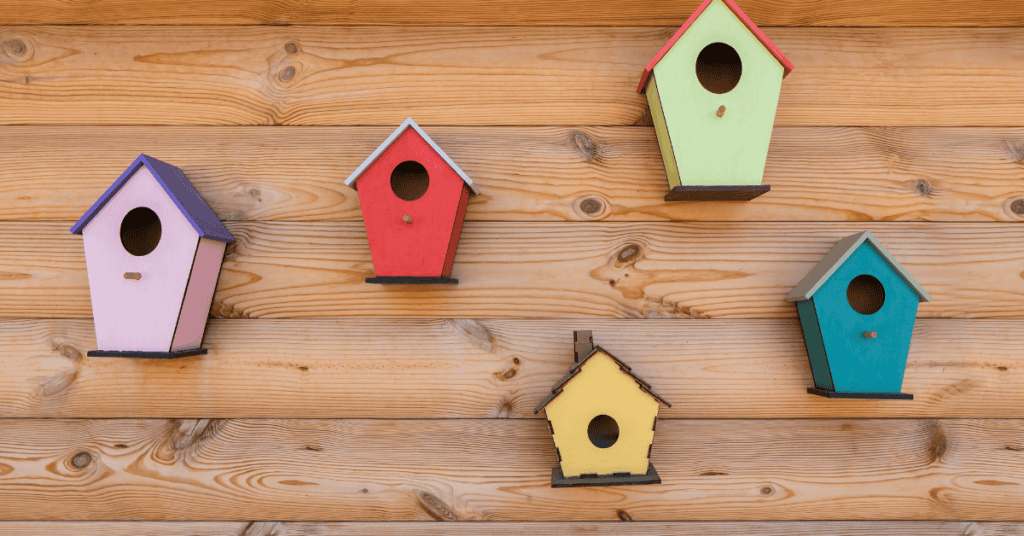
Birds naturally seek shelter that blends with their habitat. Earth tones like browns and greens often work best in wooded areas. Nest boxes and feeding area can help birds feel secure from predators.
In urban settings, birdhouses can match nearby structures while still incorporating natural elements. A tan or gray house complements both building materials and tree bark.
Desert environments benefit from sand-colored houses that mirror the landscape. The right color match increases the chances of attracting native species while protecting them from hawks and predators.
Considering Local Flora in Color Selection
Native plants provide excellent color inspiration for birdhouses. Look at your garden’s dominant flowers, leaves, and bark for natural color guidance.
A garden filled with purple coneflowers and black-eyed susans might suggest warm browns with yellow or purple accents. These familiar colors help birds recognize the birdhouse as part of their natural habitat.
Pine forests call for deep greens and rich browns, while meadow settings work well with lighter sage greens and wheat colors.
Seasonal Changes and Color Relevance
All birds activity levels will shift with the seasons. In turn these seasonal shifts can affect their color preferences. Spring brings more vibrant colors as birds seek mates, making brighter accent colors more appealing.
During fall and winter, subdued colors become more practical. Browns and grays help maintain camouflage when trees lose their leaves.
Consider using UV-resistant paints to prevent fading. This helps maintain the birdhouse’s appearance and protective qualities throughout the year.
Remember to clean and touch up paint before each breeding season. Fresh paint helps protect the wood. Plus it maintains the birdhouse’s attractiveness to your backyard friends!
Popular Birdhouse Colors Ranked
Birds display distinct color preferences for their nesting boxes, with research showing they favor colors found in their natural habitats. Different species exhibit varying preferences, with most drawn to natural, muted tones that blend seamlessly into the environment.
Why Natural Greens Are Favored
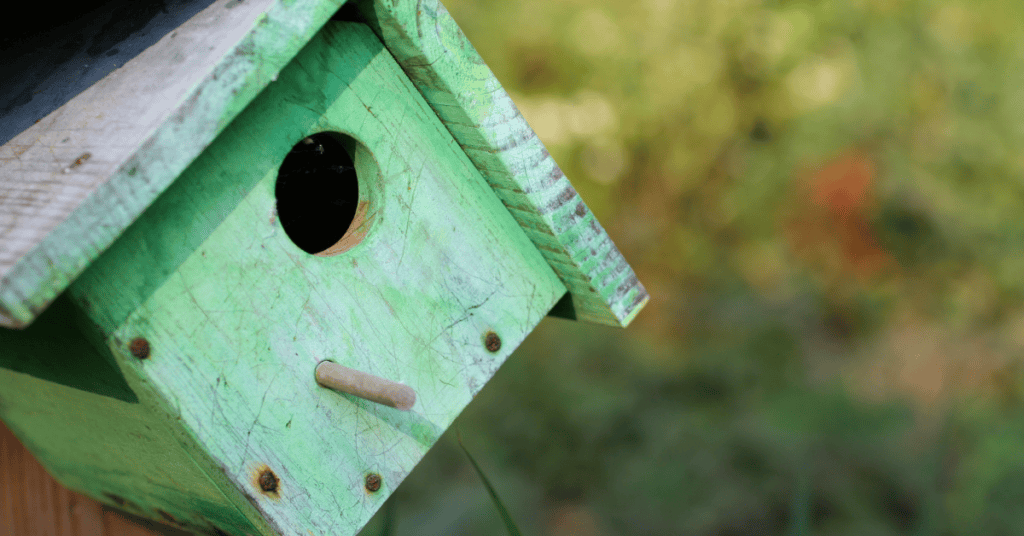
Green birdhouses attract a wide variety of native birds, especially those that nest in wooded areas. Forest species like chickadees and nuthatches show a strong attraction to sage, olive, and moss-colored houses.
These shades provide excellent camouflage from predators, making birds feel more secure in their homes. Studies show that birds are 40% more likely to choose greenhouses than brighter alternatives.
Garden birds particularly appreciate hunter-green and forest-green tones; these colors mirror their leafy surroundings. Many successful backyard birders paint their houses in subtle green shades to maximize occupancy rates.
The Appeal of Blue Hues

Blue birdhouses hold special appeal for cavity-nesting songbirds like bluebirds and tree swallows. Light blue shades remind birds of open skies, creating a welcoming environment.
Purple martins show a marked preference for pale blue houses, with nesting rates increasing by 30% compared to other colors. Colonial nesters often choose communities of blue houses.
Navy and cobalt tones work well in garden settings, offering enough visibility for birds to locate their homes while maintaining a natural appearance. These deeper blues complement existing landscape features.
Calming Effect of Earthy Browns
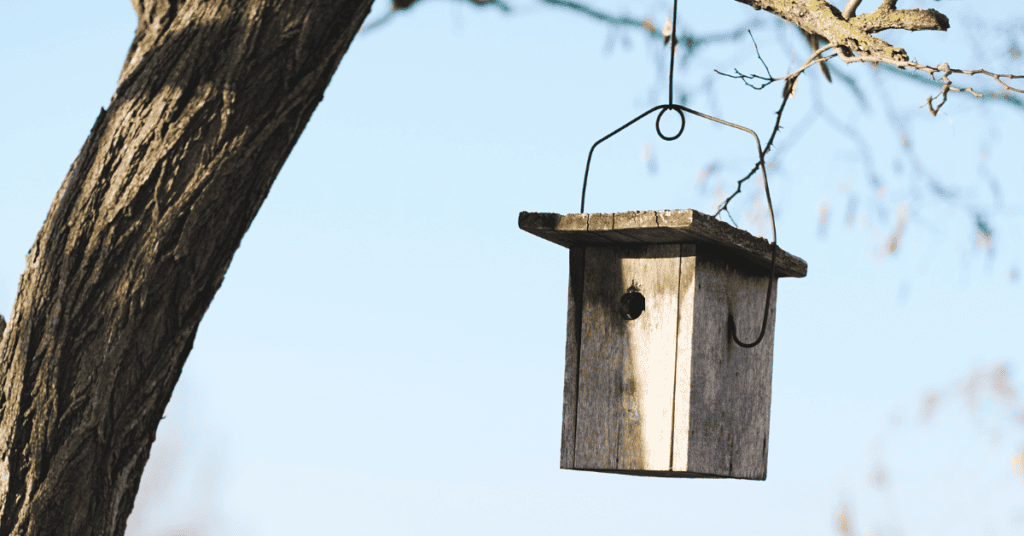
Natural wood tones and brown hues create a sense of security for cavity-nesting birds. Cedar, pine, and oak-colored houses appeal to woodpeckers, wrens, and nuthatches.
Birds instinctively recognize these colors as similar to tree bark and natural nesting sites. Unpainted wooden houses weather to an attractive gray-brown that many species prefer.
Earth-toned houses blend perfectly with tree trunks and branches, offering excellent camouflage. These neutral shades work well in any setting and typically last longer than painted alternatives.
Vibrant Reds and Yellows
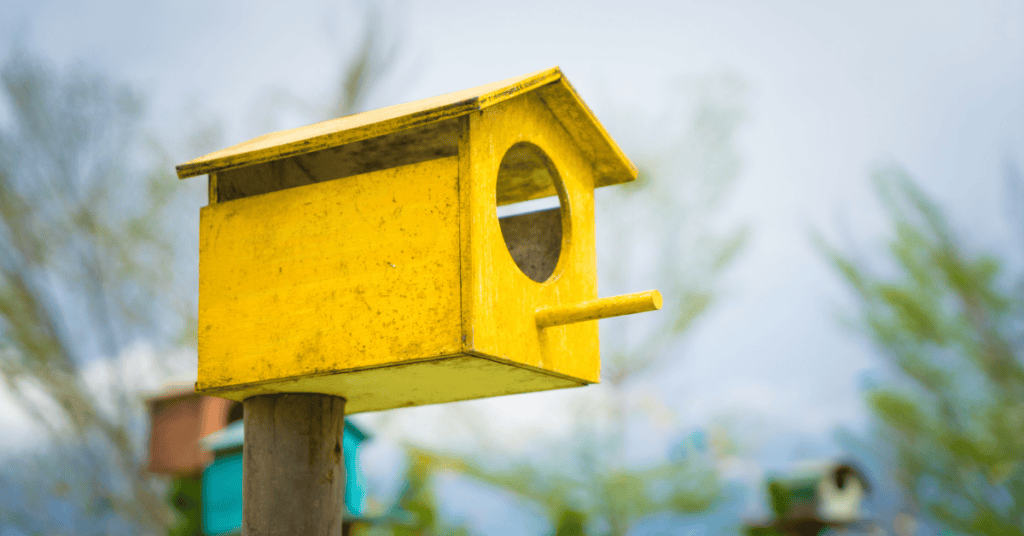
Some bird species respond positively to brighter colors, particularly hummingbirds and orioles. Red houses can attract hummingbirds, finches, cardinals, to your yard. But just remember that hummingbirds wont usually go into birdhouses.
Yellow birdhouses catch attention without overwhelming the landscape. These cheerful colors work best when used sparingly among more natural tones.
Bright color tips:
- Place red houses in flowering gardens
- Use yellow sparingly in sunny spots
- Combine with neutral colors
- Refresh paint annually to maintain appeal
Incorporating Birdhouse Colors into Your Garden
Strategic color selection and placement of birdhouses create visual appeal while attracting desired bird species. The right color combinations enhance garden aesthetics and create natural harmony with existing landscaping elements.
Harmonizing Birdhouses with Garden Design
Choose birdhouse colors that complement existing garden features like flowers, shrubs, and structures. Natural earth tones like browns and greens blend seamlessly with vegetation and create a calming environment.
Bright accent colors can create charming focal points when used sparingly. A red birdhouse nestled among green foliage draws the eye while still feeling integrated.
Consider the seasonal changes in your garden. A pale blue or soft yellow birdhouse maintains visual interest even when flowers aren’t blooming.
Selecting Colors Based on Bird Feeder Types
Platform feeders work well in natural wood tones that won’t startle ground-feeding birds like cardinals and juncos. These species prefer subtle colors that mimic their natural habitat.
Popular Bird Feeder Color Combinations:
- Tube feeders: Green, brown, or clear
- Nectar feeders: Red or orange to attract hummingbirds
- Hopper feeders: Earth tones with bright roof accents
Using Native Plants to Complement Birdhouse Colors
Native flowering plants provide natural color coordination with birdhouses. Purple coneflowers and black-eyed susans create stunning backdrops for white or pale blue houses.
Plant clusters of native grasses around earth-toned birdhouses to create disguised nesting spots. Birds feel more secure when houses blend with the surrounding vegetation.
Consider bloom times when planning your color scheme. Spring bulbs complement pastel birdhouses, while late-summer wildflowers work with deeper hues.
How to Paint Your Birdhouse
Painting your birdhouse requires careful attention to safety, paint selection, and application techniques to create a durable home that attracts birds while protecting their health.
Safe Painting Practices
Always paint your birdhouse before assembly to prevent paint from pooling in corners where birds might peck. More importantluy always work in a well-ventilated area. We suggest you do the painting outdoors or in a garage with open doors.
Sand all surfaces smooth with medium-grit sandpaper to remove splinters and rough spots. Birds can injure themselves on sharp edges.
Apply thin coats of paint using a small brush or foam roller. Doing a thin layer prevents drips and ensures even coverage.
Let each coat dry completely for 24-48 hours before applying the next layer. The extra drying time helps eliminate harmful fumes.
Choosing Non-Toxic Paints
Select water-based acrylic or latex paints labeled as non-toxic and safe for outdoor use. These paints release fewer harmful chemicals than oil-based alternatives.
Avoid paints containing lead, mercury, or other heavy metals. Look for “Zero VOC” or “Low VOC” on the label.
Natural milk paints offer a safe alternative. They’re made from milk protein, lime, and natural pigments.
Test the paint on a small wood sample first to ensure proper adhesion and drying.
Color Durability against Sunlight
Light colors reflect sunlight better than dark shades, helping maintain cooler temperatures inside the birdhouse.
UV-resistant paints maintain their vibrancy longer and prevent color fading. Look for products specifically designed for exterior use.
Apply a clear, non-toxic sealant over the paint to extend its life. Choose a water-based product that’s safe for wildlife.
Plan to repaint every 2-3 years, depending on sun exposure and weather conditions. Watch for signs of peeling or fading.
Birdwatching and Color Impact
Birds demonstrate clear preferences for specific colors. So when you selecting nesting sites and feeders, keep this in mind for your backyard feathered friends.
Observing Avian Reactions to Color
Setting up multiple birdhouses in different colors creates an ideal testing environment for tracking bird behavior. To maintain controlled conditions, place identical houses in varied hues at similar heights and locations.
Birds often pause and inspect houses before making their selection. Keep a log of which species approach each color and note their initial reactions.
Morning and evening hours provide peak observation times when birds are most active. Use binoculars from a safe distance to avoid disrupting natural behavior patterns.
Take photos or videos to capture bird interactions with different colored houses. Documentation helps track multiple visits and identify repeated color preferences among specific species.
Documenting Results for Birdwatchers
Create a simple chart to record daily visits to each colored birdhouse. Include essential details like species, time of day, and length of stay.
You can share successful color combinations with local birdwatching groups. Many birding clubs maintain databases of effective house colors for different regions.
Best practice: Keep notes on seasonal variations in color preferences. Birds might show different preferences during the breeding season versus other times of the year.
Share findings through social media or birding apps to help fellow enthusiasts. Include photos of successful birdhouse setups to provide visual examples.